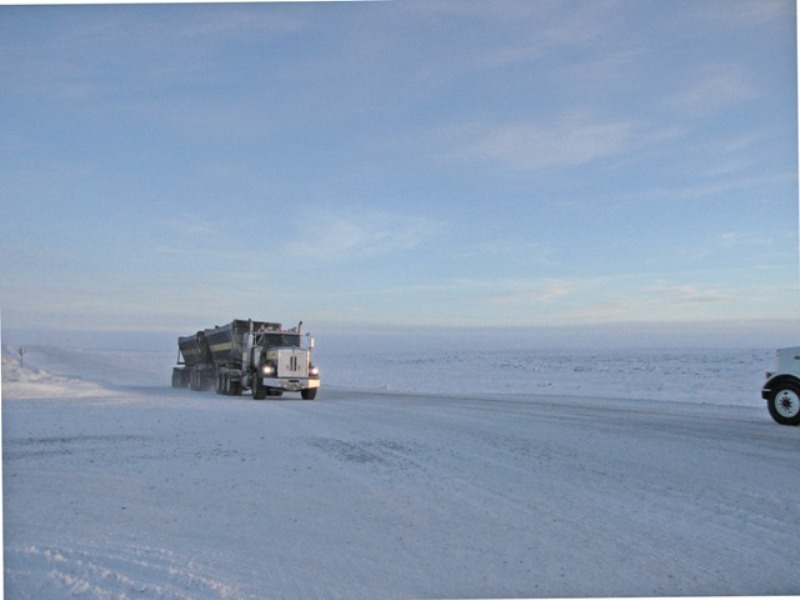JV Article: Climate-driven impacts present risks to infrastructure built on permafrost


Surface infrastructure including roads, airstrips, buildings, and tailings dams often relies on permafrost’s frozen state for stability. These structures, however, are becoming increasingly vulnerable to ground warming that causes the permafrost to thaw, which can lead to ground settlement and soil creep.
“Permafrost is not a static condition; it's dynamic and constantly changing,” explains Stevens, a geocryologist with over 18 years of experience working on mining, transportation, and oil and gas projects in the U.S., Canada, Russia, and Greenland. “It has complex temperature-dependent properties that alter the hydraulic and mechanical properties of the soil. At some sites, ground warming is degrading the permafrost, resulting in deeper seasonal thaw and changes in ground stability.”
Scientists and engineers widely accept permafrost is changing due to climate‑driven impacts. Less understood is what these changes could mean for operating mines or the long-term closure of projects located in permafrost settings.
Climate change adds an “additional level of uncertainty,” says Stevens, due to the unknown role future conditions may have on the thermal profile of the ground.
Companies with operations in the Arctic are vulnerable to climate-driven impacts as temperatures are warming twice as fast as the global average, with profound changes to permafrost already being widely observed.
Permafrost-related risks are emerging as an essential consideration when developing new and existing projects, says Stevens. “If not adequately identified and managed, the changes to permafrost from climate-driven stressors can increase environmental and operational risks to mining projects, potentially leading to significant financial costs for operators.”
While the more widely observed impacts on permafrost are from ground warming and thaw that can alter the stability of foundations and cause infrastructure distress, the secondary effects of permafrost degradation on the surrounding environment can also impact operating conditions and environmental compliance.
“The most rapid changes to permafrost can result from thermal erosion or the combined thermal and mechanical erosion of ice-rich permafrost and massive ground ice,” explains Stevens. “These conditions can lead to rapid structural failure of infrastructure, loss of containment of fuel or mine waste, and even human injury and fatality.”
These changes to the thermal and physical properties of ice-rich permafrost foundation soils present a “unique challenge” to the design, operation, and closure of mine waste facilities, he says.
The long-term downslope displacement of some mine waste facilities, Stevens notes, has been observed several meters a day or more due to the deformation of permafrost soils in the foundation.
Permafrost thaw and elevated porewater pressure in foundations have also contributed to waste-rock dump failures. While these conditions do not happen everywhere, they are a major consideration for the design and operation of mine waste facilities and require evaluation on a site-specific basis in permafrost environments.
The cumulative effects of permafrost thaw can also include changes to baseline water quantity and quality, altering surface and groundwater flow. These can result in the release of higher-ionic concentration water and increased reactivity of recently thawed soil and rock.
Another consequence, perhaps more important from a mining company perspective, is water released from permafrost thaw can cause “background” water chemistry to be different from “baseline” water chemistry. That can have profound implications for mining companies, including additional monitoring at a minimum and loss of regulator and stakeholder trust that a mine’s impacts have been predicted accurately or monitored appropriately. Changing background conditions have the potential to be a real problem for some projects.
Mining companies should take steps early in the project’s development to identify and assess the potential risks from the climate-driven impacts on the permafrost conditions around their operations, says Stevens. “These include geotechnical evaluations of the permafrost soil and rock properties and its distribution, terrain, and hazards mapping, and climate and permafrost monitoring at a site, among other baseline studies.”
Permafrost monitoring and analysis, he says, should also be conducted throughout the development of the project, from early-stage mine planning through to closure, providing project developers with the data to make informed decisions on how to address potential issues before they become unexpected problems. Monitoring may also allow for timely mitigation, which can minimize the costs of repairing infrastructure.
“Developing a focused climate change risk assessment would allow companies to identify adjustments needed to achieve resilient infrastructure designs and retroactive modifications that can be made during their operation,” says Stevens.
A risk assessment, he continues, may identify inadequacies in current practices, sensitivities to critical environmental and operational conditions, previously unrecognized hazards and modes of failure, and additional monitoring needs that utilize the latest technology.
However, Stevens warns that such assessments would provide little to no value without an implementation plan to guide short-term adaptation and long-term project planning of what might be, in hindsight, a very foreseeable outcome. “Adapting existing infrastructures to meet current and future needs is a critical part of a proactive approach.”
Adopting a more proactive approach to addressing climate-driven impacts on infrastructure, he adds, can add significant value to the project by reducing the risk profile of mining infrastructure.
Christopher Stevens, PhD, is a Senior Geocryologist at SRK Consulting, and has over 18 years of experience working on Arctic and Subarctic projects.
The preceding Joint Venture Article is PROMOTED CONTENT sponsored by SRK Consulting and produced in cooperation with Canadian Mining Journal. Visit www.SRK.com for more information.
Comments